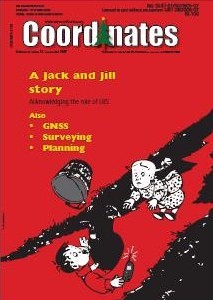
Nano effects
A historic moment.
For the automobile industry and for India too.
Tata unveiled small car Nano with a price tag of US$ 2,500.
When this ‘car for masses’ was promised, many did not believe.
Now it is a reality.
A revolutionary innovation.
An innovation that may change the life of millions.
GNSS technology too has this potential.
For imaginative applications and wider …

Ajay Seth,
Managing Director of Elcome Technologies on being acquired by Hexagon
What was the thought behind this acquisition?
The Indian market is growing very rapidly. From Hexagon’s perspective as well as the Indian point of view, we need to grow faster and this requires investment. Hexagon could help us achieve this …
January 2008
Institute of navigation national technical Meeting
January,28-30, 2007,
San Diego, California, USA
www.ion.org
February 2008
Mobile World congress 2008
February 11 – 14,
Barcelona, Spain
www.mobileworldcongress.com
Munich satellite navigation summit
19 – 21 February, 2008,
Residenz München, Germany
http://www.munich-satellitenavigationsummit.org/
GSDI-10 St.Augustine, Trinidad
February 25-29, 2008
http://www.gsdi.org/gsdi10/
NavtechGPS Seminars
February 25-29, 2008
New Orleans, LA
PWitt@navtechgps.com
March 2008
CeBIT
March 4-9,
Hannover Germany
www.cebit.de
WAlIS Forum 2008
March 12-14,
Perth, Western Australia
forum@walis.wa.gov.au
http://www.walis.wa.gov.au/forum
April 2008
GEO-SIBERIA 2008
April 22 – 24, 2008,
Novosibirsk , Russia,
strutz@sibfair.ru
http://geosiberia.sibfair.ru/eng/n
Space …

Galileo gets the go-ahead
Galileo finally got the go-ahead at the end of November when European nations involved in the project agreed to build the EUR 3.4 billion satellite navigation system. Thirty satellites will be placed in a mid-earth orbit and supported by ground stations in Italy and Germany. A third ground centre dedicated to civil protection, in particular in the area of maritime, air and rail security, will be based in Spain. This control centre is expected to take on further responsibilities as the Galileo system is developed. www.djnewswires.com/eu

Better ‘eye’ in space for Malaysia
Weighing 180 kg and with a 2.5 m resolution, Malaysia’s second remotesensing satellite shall provide images every 100 minutes. The RazakSAT is expected to be launched into space by the middle of this year. The satellite was jointly developed by Astronautic Technology (M) Sdn Bhd and Satellite Technology Research Center Initiative Co Ltd, South Korea. The cost of the RazakSAT programme is RM60 million. http://www.nst.com.my/

Mapping center of israel to launch Geography portal
The Mapping Center of Israel (MAPI) will soon launch a new national geography portal. The new site will have 120 information levels about land, outline plans, maps, trips, sites, aerial images, and historical maps. The maps on the site were created through collaboration with various ministries and will be free. www.globes.co.il

Rakesh Verma
CEO, MapMyIndia,
CE Systems on navigation market in India
How do you see the success of the Navigator in India where we culturally depend on word of mouth for directions?
There is a significant need for a GPS navigation device for all India . Depending on word of mouth for directions has set in as culture in …
January 2008
Institute of navigation national technical Meeting
January,28-30, 2007,
San Diego, California, USA
www.ion.org
February 2008
Mobile World congress 2008
February 11 – 14,
Barcelona, Spain
www.mobileworldcongress.com
Munich satellite navigation summit
19 – 21 February, 2008,
Residenz München, Germany
http://www.munich-satellitenavigationsummit.org/
GSDI-10 St.Augustine, Trinidad
February 25-29, 2008
http://www.gsdi.org/gsdi10/
NavtechGPS Seminars
February 25-29, 2008
New Orleans, LA
PWitt@navtechgps.com
March 2008
CeBIT
March 4-9,
Hannover Germany
www.cebit.de
WAlIS Forum 2008
March 12-14,
Perth, Western Australia
forum@walis.wa.gov.au
http://www.walis.wa.gov.au/forum
April 2008
GEO-SIBERIA 2008
April 22 – 24, 2008,
Novosibirsk , Russia,
strutz@sibfair.ru
http://geosiberia.sibfair.ru/eng/n
Space …

The LBS stream
It’s integral to the day-to-day functioning in the developed world.
In Asia, Japan and Korea lead the way.
The undercurrents are becoming visible in India.
First, it was the state-owned BSNL to join the LBS bandwagon.
Later, the private player Bharti Airtel followed suit.
Market dynamics indicate positive trends for LBS.
With the mobile phones holding the pulse of …











 (5.00 out of 5)
(5.00 out of 5)